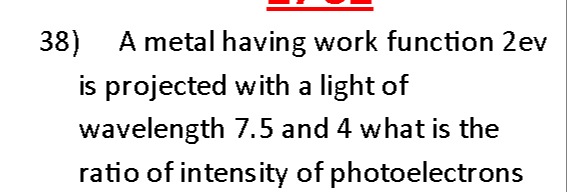Question
Question: A metal having work function 2ev is projected with a light of wavelength 7.5 and 4 what is the ratio...
A metal having work function 2ev is projected with a light of wavelength 7.5 and 4 what is the ratio of intensity of photoelectrons

1:1
1:1
Solution
The problem asks for the ratio of the intensity of photoelectrons when a metal with a given work function is illuminated by light of two different wavelengths.
-
Work Function and Threshold Wavelength: The work function of the metal is given as ϕ=2 eV. The threshold wavelength (λ0) is the maximum wavelength of light that can cause photoemission. It can be calculated using the formula: ϕ=λ0hc Using the convenient constant hc=1240 eV nm: λ0=2 eV1240 eV nm=620 nm
-
Check for Photoemission: The given wavelengths are λ1=7.5 (presumably nm) and λ2=4 (presumably nm). Since both λ1=7.5 nm and λ2=4 nm are much smaller than the threshold wavelength λ0=620 nm, the energy of the incident photons is greater than the work function. Therefore, photoemission will occur for both wavelengths.
-
Intensity of Photoelectrons: In the photoelectric effect, the "intensity of photoelectrons" refers to the rate at which photoelectrons are emitted, which is directly proportional to the photocurrent. The number of photoelectrons emitted per unit time (and thus the photocurrent or "intensity of photoelectrons") is directly proportional to the intensity of the incident light, provided the photon energy is above the work function. It does not depend on the frequency or wavelength of the incident light.
-
Ratio Calculation: The problem provides the wavelengths but does not provide any information about the intensities of the incident lights for these two wavelengths. In the absence of such information, it is a standard assumption in physics problems that the incident light intensities are equal. Let Iinc1 and Iinc2 be the intensities of the incident lights corresponding to λ1 and λ2. Let Ne1 and Ne2 be the number of photoelectrons emitted per unit time (or "intensity of photoelectrons") for λ1 and λ2. We have Ne1∝Iinc1 and Ne2∝Iinc2. The ratio of the intensity of photoelectrons is Ne2Ne1=Iinc2Iinc1. Assuming Iinc1=Iinc2 (i.e., the incident lights have the same intensity), then: Ne2Ne1=11
Thus, the ratio of the intensity of photoelectrons is 1:1.
Explanation of the solution: The work function determines the threshold wavelength for photoemission. Both given wavelengths are much shorter than the threshold wavelength, ensuring photoemission. The "intensity of photoelectrons" (i.e., the number of electrons emitted per second) is directly proportional to the intensity of the incident light, not its wavelength, as long as photoemission occurs. Since the incident light intensities are not specified, they are assumed to be equal, leading to a 1:1 ratio of photoelectron intensities.
